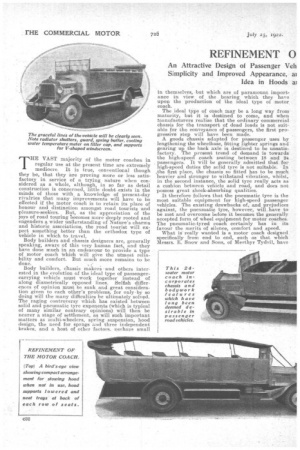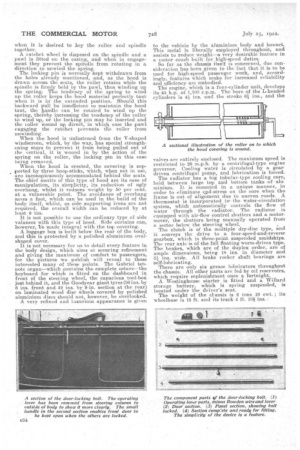REFINEMENT 0 MOTOR COACH.
Page 14

Page 15

Page 16

If you've noticed an error in this article please click here to report it so we can fix it.
THE VAST majority of the motor coaches in regular use at the present time are extremely mediocre. It is true, conventional though they be, that they are proving more or less satisfactory in service of a trying nature when considered. as a whole, although, in so far as detail construction is concerned, little doubt exists in the minds of those with a knowledge of present-day rivalries that many improvements will have to be effected if the motor coach is to retain its place of honour and distinction amongst road tourists and pleasure-seekers. But, as the appreciation of the joys of road touring becomes more deeply rooted and engenders a wider understanding of Nature's charms and historic asseciatione, the road tourist will expect something better than the orthodox type of vehicle in which to travel.
Body builders and chassis designers are, generally speaking, aware of this very human fact, and they have done much in an endeavour to provide a type of motor coach Avhich will give the utmost reliability and comfort. But much more remains to be done.
Body builders, chassis makers and others interested in the evolution of the ideal type of passengercarrying vehicle must work together instead of along diametrically opposed lines. Selfish differences of opinion must be sunk and great consideration given to each other's problems, for only-by so doing will the many difficulties be ultimately solved. The raging controversy which has existed between solid and pneumatic tyre exponents (which is typical of many similar contrary opinions) will then be nearer a stage of settlement, as will such important matters as multi-wheelers, spring suspension, hood design, the need for sprap and three independent brakes, and a host of other factors. perhaps small
in themselves, but which are of paramount importance in view, of the bearing which they have upon the production of the ideal type of motor coach.
The ideal type of coach may be a long way frorri maturity, but it is destined to come, and when manufacturers realize that the ordinary commercial chassis for the transport of dead loads is not suitable for the conveyance of passengers, the first progressive step will have been made. A goods chassis adapted for passenger uses by lengthening the wheelbase, fitting lighter springs and gearing up the back axle is "destined to be unsatisfactory. The present trend of demand is towards the high-speed roach seating between 18 and 24 passengers. It will be generally admitted that for high-speed duties the solid tyre is not suitable. In the first place, the chassis so fitted has to be much heavier and stronger to withstand vibration, whilst, in the second instance, the solid tyre really acts as a cushion between vehicle and road, and does not possess great shook-absorbing qualities. It therefore follows that the pneumatic tyre is the most suitable equipment for high-speed passenger vehicles. The existing drawbacks of, and prejudices against, the pneumatic tyre, however, will_ have to be met and overcome before it becomes the generally accepted form of wheel equipment for motor coaches. The pneumatic-tyred coach certainly has in its favour the merits of silence, comfort and speed. What is really wanted is a motor coach designed specifically from end to end, such as that Which Messrs. E. Snow and Sons, of Merthyr Tydvil, have recently had built to their designs by the Ward La France Truck Corporation, Elmira, New York, who are specialists in the manufacture of high-speed pneumatic-tyred vehicles. We do not say for one moment that this vehicle, of which several illustrations appear on these pages, embodies all those refinements which are deemed desirable (in some respects it falls far short of preconceived ideals), but that it is an advance on many existing types cannot be denied. Speed, power, luxury, comfort, simplicity and accessibility have each received its quota of consideration in its composition, and the chassis and body each incorporate features which call for special mention, two of the most interesting being the door-locking arrangement and the special type of hood.
The body has been built regardless of cost. It is constructed of polished aluminium panels throughout, the framework being of the usual build. The upholstery, which is of green morocco leather, is most luxurious; so far as the seats are concerned, it is of the double-sprung variety, each seat being 1 ft. in depth. To give additional comfort to passengers who have plenty of room in which to lounge or sit erect, slanting footrests are fitted to the floorboards.
• The seating is of the conventional type, with a door to each row of seats. Messrs. Snow favour this • type instead of the corridor type of coach, chiefly on the score of ease Jf entrance and exit. With the smaller type of coach body waste space is taboo, but in the larger types of vehicles, where torsion of the body usually introduces difficulties in opening and closing the doors, we think it desirable to keep the number of door openings down to the minimum.
Of course, door difficulties are not present in Messrs. Snow's coach, for they have patented a sliding bolt which prevents the doors from flying open. This door-locking device, of which illustrations are published on the next page, is extremely simple, and is operated from the driver's seat by means of a Bowden wire control attached to the steering column. The component parts of the device can be clearly seen from one of our pictures, and its method of • application is self-explanatory. The bolt consists of three main parts, these being the lever and controls, the door section and the panel section. A sectional tube, which extends almost the full length of the body, encloses a series of spring-operated bolts, which lock or unlock the doors when operated by the driver. A small handle is fitted in the second section from the front, which enables the driver to lock all doors when he alights from the front seat and desires to keep the front door open.
-,Quite a number of serious accidents have occurred to passengers through doors flying open when the vehicle is travelling, but such a device effectively overcomes this possibility.
Another feature which is hardly of lesser importance than the door-locking device is the new type of hood which, it is said, can be erected quite comfortably in 30 seconds. We reproduce a sectional drawing of the hood roller on which the covering is wound ; from this it will be seen that the roller is provided, with a central spindle to which a spring is attached at one end and at the other to the roller. Holes are provided at one end of the roller and the spindle, through which a locking pin can be inserted
when it is desired to key the roller and spindle together.
A ratchet wheel is disposed on the spindle and a pawl is fitted on the casing, and when in engagement they prevent the spihdle from rotating in a direction to -unwind the spring.
The locking pin is normally kept withdrawn from the holes already mentioned, and as the hood is drawn across the seats, the roller rotates while the spindle is firmly held by the pawl, 'thus winding up the spring. The tendency of the spring to wind up the roller keeps the hood material perfectly taut when it is in the extended position. Should this backward pull be insufficient to maintain the hood taut, the handle can be rotated to wind up the spring, thereby increasing the tendency of the roller to wind up, or the locking pin may be inserted and the roller wound up direct, in which case the pawl engaging the ratchet prevents the roller from unwinding.
When the hood is unfastened from the V-shaped windscreen, which, by the way, has special strengthening stays to prevent it from being pulled out of the vertical, it is wound in by the action of the spring on the roller, the locking pin in this case being removed.
When the hood is erected, the covering is supported by three hoop-sticks, which, when not in use, are inconspicuously accommodated behind the seats. The chief merits of this type of hood are its ease of manipulation, its simplicity, its reduction of ugly overhang, whilst it reduces weight by 50 per cent. at a. vulnerable point. The avoidance of overhang saves a foot, which can be used in the build of the body itself, whilst, as side supporting irons are not required, the overall width can be reduced by at least 6 ins.
It is not possible to use the ordinary type of side valances with this type of hood. Side curtains can, however, h-e made integral with the top covering.
A luggage box is built below the rear of the body, and this is protected by a polished aluminium ovalshaped cover.
It is not necessary for us to detail every feature in the body design, which aims at securing refinement and giving the maximum of comfort to passengers, for the pictures we publish will reveal to those interested many of these points. The Gabriel tennote organ—which contains the complete octave—the keyboard for which is fitted on the dashboard in front of the steering wheel, the capacious tool-box just behind it, and the Goodyear giant tyres (36 ins. by 6 ins, front and 42 ins. by 9-in. section at the rear) on laminated wood disc wheels covered by polished aluminium discs should not, however, be overlooked. A very refined and luxurious appearance is given
to the vehicle by the aluminium body and .bonnet. This metal is liberally employed throughout, and assists to reduce weight—a very desirable feature in a motor coach built for high-speed duties, So far as the chassis itself is concerned, due consideration has been given to the fact that it is to be used for high-speed passenger work, and, accordingly, features which make for increased reliability and efficiency are embodied.
The engine, which is a four-cylinder unit, develops its 45 h.p. at 1,100 r.p.rn. The bore of the L-headed cylinders is 41 ins, and the stroke 6/ ins., and the valves are entirely enclosed. The maximum speed is restricted to 26 m.p.h. by a centrifugal-type engine governor. Cooling water is circulated by a gear. driven centrifugal pump, and lubrication is forced. The radiator has a big tubular-type cooling core, held between large top and bottom tanks of aluminium. It is mounted in a unique manner, in order to eliminate end-stress on the core when the frame is out of alignment due to uneven roads. A thermostat is incorporated ire the water-circulation system, which automatically controls the flow of water through the radiator. The radiator is equipped with air-flow control shutters and a motormeter, the shutters being manually operated from a sector below the steering wheel. The clutch is of the multiple dry-disc type, and it conveys the drive to a four-speed-and-reverse gearbox, which is three-point suspended amidships. The rear axle is of the full floating worm-driven type. The brakes, which are of the duplex order, are of ample dimensions, being 18 ins, in diameter and 31 ins. wide. All brake rocker shaft bearings are self-lubricating. There are only six grease lubricators throughout the chassis. All other parts are fed. by oil reservoirs, which require replenishment once a fortnight. A Westinghouse starter is fitted and a Willard storage battery, which is spring suspended, is located under the driver's seat.
The weight of the chassis is 2 tons 10 cwt. ; its wheelbase is 15 ft. and its track 4 ft. 10i ins.






























